FRENCH BASQUE COUNTRY AND THE PYRENEES
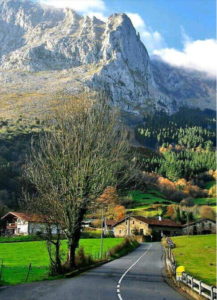
Located down in the most south-westerly tip of France, this small area is the last region in the country before crossing into its larger Basque neighbour over the Spanish border. Most visitors cling to the beautiful coastal area around the trés chic city of Biarritz, but venture further inland from Bayonne and you’ll soon be immersed in the rich Pays Basque with its own distinct culture.
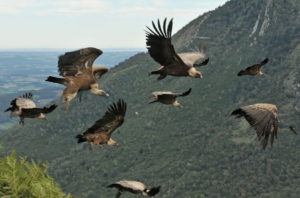
This is an underpopulated, rugged region, officially the department of Pyrénées-Atlantiques, defined by stunning countryside, snow-capped mountains, deep gorges, steep mountain passes that attract intrepid hikers, you’ll find shepherds tending flocks of sheep, and even a different language. As well, the region is also an important haven for eagles, griffon vultures, brown bears and other wildlife.
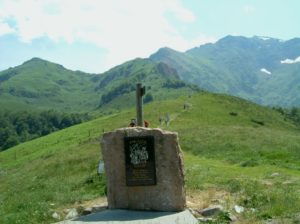
The region has long had a turbulent history going back many centuries. In more recent times, during the German occupation of France during World War II, many of these villages bordering the frontier were fully administered by the German military, but were also an escape route for British soldiers, French Resistance members, and European Jews trying to reach neutral Spain.

As you explore further beyond the coast, the cultural differences become very evident. One distinct difference will soon be obvious: you are likely to hear more Basque than French being spoken. In decline—indeed, repressed—since the Revolution, Basque culture is flourishing once more. Thanks to a concerted effort to have schools bilingual and through TV channels (mostly broadcast from over the border), radio stations, books and magazines, Basques have rediscovered their culture and endangered language.
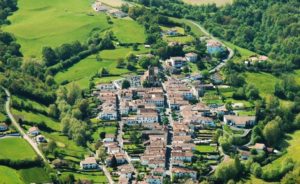
Officially in the Pyrénées-Atlantiques department, a great place to start exploring the Pays Basque is La Bastide-Clairence.
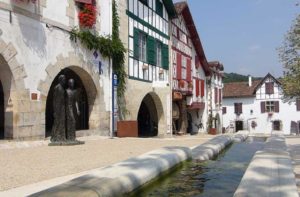
Located about 20 kms east of Bayonne, it’s classified as one of the Plus Beaux Villages de France. Founded in 1312 by the Kingdom of Navarre to allow a path through to the ocean, this beautiful bastide has an attractive central square with arcades. A picturesque stream, La Joyeuse, flows through the town.
Typical of the Basque region, the town’s architecture presents a harmonious picture with its buildings in the traditional white render, half-timbering and shutters painted in the emblematic Basque colours of deep red or green, pitched roofs, carved window mullions and lintels.
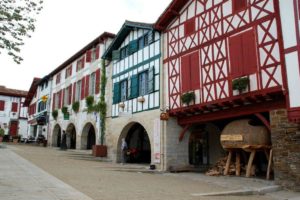
Today, the houses around Place des Arceaux are filled with local artisan craftspeople, many of whose forebears were Spanish refugees who had fled the Inquisition, pilgrims to Santiago de Compostela, and a Jewish community that had sought refuge after being expelled from Portugal in the 16th and 17th centuries.
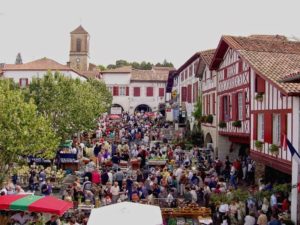
The town was particularly well regarded for its smiths, nail makers, locksmiths and woollen garments. Today, it’s known for its good quality artisan crafts and locally produced products such as ham, foie gras, le Piment d’Espelette (spicy chilli pepper), sheep cheese, honey, spice bread, Gateau Basque, a traditional cake, and of course, the famous Basque espadrilles (sandals). One of the region’s best-known events is the annual Pottery Market held during the second weekend of September.
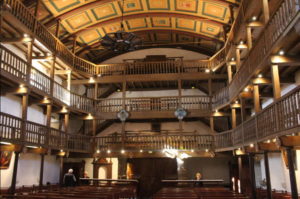
A visit to the imposing church of Notre-Dame-de-l’Assomption is a must to admire the interior which has three floors of timber galleries around the perimeter—again, typical of many Basque village churches.
About 30kms south west of La Bastide-Clairence and only 3 kms from the Spanish border, is yet another of the Plus Beaux Villages, the little village of Ainhoa. It was built during the 13th century for use by the nearby Urbazubi-Urdax Monastery and has served as a place of shelter for pilgrims on the way to Santiago de Compostela.
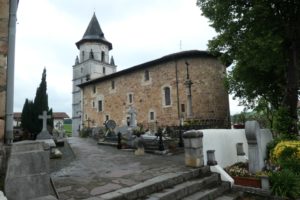
Very similar in appearance to La Bastide-Clairence, with its white rendered buildings with Basque red timber shutters and trims, the whole town was destroyed during the Thirty Years War in the 17th century. It was entirely rebuilt in the traditional Basque style we see today.
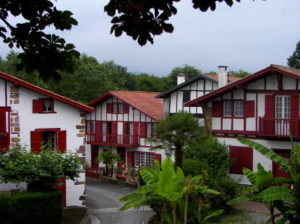
Once known for its flax weaving, today it’s tourism activities, focussed around its architectural and cultural heritage that are the economic mainstay of the town.
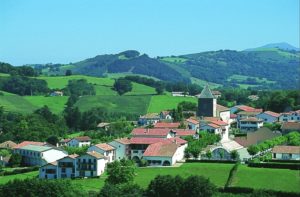
Another little gem is about 9 kms west of Ainhoa, and about 15 kms from the coast.
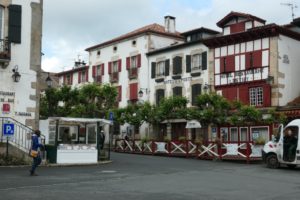
Sare is also designated as one of the Plus Beaux Villages de France, and sits right on the border with Spain and backed by the mountains of the Pyrenees.
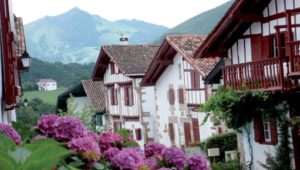
Sare is built in the same typical Basque architectural style, and to appreciate not only the exterior but the interior of traditional houses, you can step back in time and visit the picturesque 17th century Maison Ortillopitz. Once the home of a ship-owner, it has been preserved to present traditional Basque life. Visitors can see the office of the owner, his reception rooms, bedrooms, traditional cider cellar, huge kitchen and traditional vegetable garden. Also well worth a visit is the majestic church of St Martin with its three floors of oak galleries.
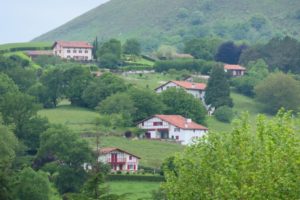
Meandering through this stunning landscape, with sheep, cattle and horses grazing on steep mountain pastures, it’s obvious that, as much as the beautiful little Basque villages, the great attraction of the region is the forests and breathtaking scenery.
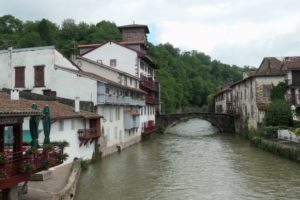
About 40 minutes east of Ainhoa is one of the gems of the entire region, the walled town of St-Jean-Pied-de-Port, once the capital of the traditional Basque province of Lower Navarre.
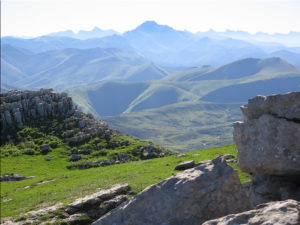
Just 8 kms from the Spanish border, it’s a starting point of the most popular route for those walking the Camino de Santiago de Compostela, as it stands at the base of the Roncevaux Pass, the arduous route across the Pyrenees. When we visited a couple of months ago, we were surprised at the large numbers of walkers gathered in the town. There are a number of hostels and small B&Bs especially catering to pilgrims, an office for those signing up for the Camino, shops catering to everything needed for hiking, as well as a number of restaurants, a couple of small hotels and quite a few vacation rental gites.
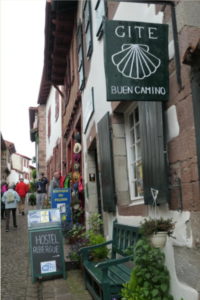
This bustling, historic town has an infectious, friendly atmosphere, not only among the many pilgrims and hiking groups, but extended to others, like us, who were simply visiting for the day. The town was added to the UNESCO World Heritage list as part of the sites along the Routes of Santiago de Compostela in France.
From the 15th century Porte St-Jacques, the cobble-stone rue de la Citadelle runs down hill and crosses over the river to the Porte d’Espagne, where there a 14th century red schist Gothic church, Notre-Dame-du-Bout.
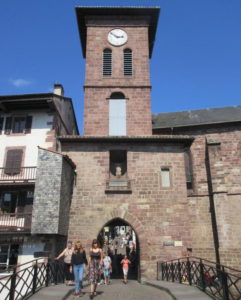
From the Roman bridge there are views of the old houses whose balconies overlook the briskly flowing river Neve. Almost every house has retained its original features, including inscriptions over their doors. One, a bakery, lists the price of wheat in 1789. At the top of the hill is the Mendiguren Citadel, which was remodelled by Vauban in the 17th century.

The town is renowned for its traditional crafts, especially Basque linen, available in any number of small shops, as well as the famous Basque sheeps’ milk cheese, fromage de brebis, traditionally made by the local shepherds. At the end of the Monday market, around 5.00pm, there is a communal game of bare-handed pelote at the town’s fronton (a specially constructed wall, up against which the game is played).
The Basque-Pyrennees region is quite unlike the rest of France, or indeed, Spain, with its unique language and culture. Exploring this fascinating, and stunningly beautiful region will be one of the most rewarding travel experiences you could wish for.
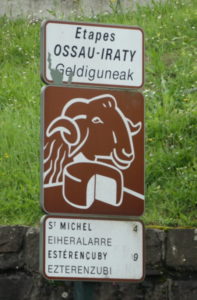

Nadine Connor
Fascinating, as always.
Cheryl Brooks
So glad you enjoyed it Nadine. It’s an area we would return to any time–too much to see in one trip!
Cheers, Cheryl